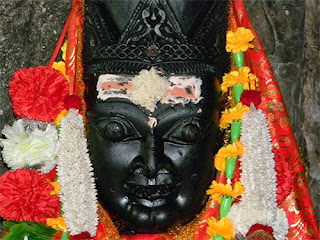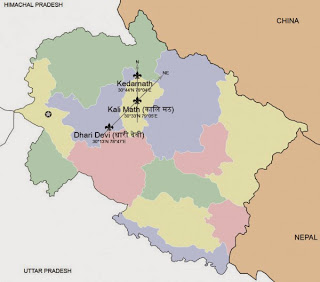This may sound like a story from a
comic book, but it is not so – its reality that most people today like to
ignore and push aside as superstition. The fury of the goddess is well known
and any attempt to instigate her would lead to great destruction. Let us look
at the events leading to the great devastation of Uttarakhand by flooding of
Uttar Kashi.
The government has tried to build up
dams to overcome the power shortage. This has been opposed by locals and some prominent
politicians like Uma Bharti and B. C. Khanduri of the BJP since it would lead
to the submergence of the Shrine, and efforts to construct dams have been
delayed indefinitely. Previously, in 1882, an attempt to shift the shrine was
immediately followed by havoc in Kedar Valley. There is some strange connection
between these guardian goddess and the Kedarnath jyotirliñga.
These are not just any other Shakti
temples, they are among the 108 Shakti Pitha mentioned in the Devi Bhagavat.
Dhari Devi is a temple on the banks of the Alaknanda River in the Garhwal
Region of Uttarakhand state, India. It houses the upper half of an idol of
goddess Kali specifically called “Dhari Devi" that, according to local lore,
changes in appearance during the day from a girl, to a woman, and then to an
old lady. Perched atop a 20 metre high rock, the temple of Dhari Devi is
situated on the banks of river Alaknada. One has to travel a distance of 19
kms. from Srinagar (Pauri Garhwal) on Srinagar-Badrinath highway upto Kaliya Saur,
then down trek another half a kilometer towards Alaknanda river.
According to a
local legened, the temple was once washed off by floods, while floating the
idol struck against a rock, the villagers heard the cries of the idol. On
reaching the site they heard a divine voice instructing them to install the
idol as it was, on the spot it was found. Since then the fierce looking idol
remains where it was, known as Dhari Devi, under the open sky, and thousands of
devotees on the way to Badrinath pay their obeisance to it. The temple of Dhari
Devi in Srinagar hosts only the upper part of idol of Godess Dhari, the
remaining lower part is believed to be in Kalimath in Rudraprayag district.
It
is believed that the idol of Dhari Devi shall not be put under roof. For the
same reason, the idols in Dhari Devi Temple are put under open sky. Taking
photographs of Dhari Devi idols is strictly prohibited. The village near the
temple is name after godess Dhari and known as Dhari Village. A hanging bridge
over Alaknanda river connects the Dhari Devi temple to Dhari Village.
Now, the lower half of the idol of Kali
is located in Kālimaṭh Temple. These joint temples are
exactly at NE-SW direction (see adjoining image) symbolising Kali as sleeping with
her feet in NE direction and head in the SE direction.
This causes the energy to flow in the
NE direction, which in jyotiṣa, is the
direction of Jupiter (Iśāna Śiva), the parameṣṭhi guru. The
upper part of the devi with the head symbolises the calming of Kali by Śiva,
the Guru. The lower part of Kali is not in the form of an idol and instead, is
worshipped as the Śri Yantra. In this manner we learn that the Śri Yantra, as
established by Adi Sankara at Kalimaṭh, is the yoni of Sakti from which all creation proceeds.
The Kedarnath jyotirlinga is exactly
North from Kālimaṭh (see adjoining image) symbolising the
husband-wife or "Siva-Sakthi" relationship. In this Kedarnath being to the north
(Mercury direction for ahimsa) is constantly calming the devi who is in the
south (Mars direction, anger, agitated and at war).
On June 15th, 2013, the idol of Dhara
Devi was removed to be shifted to another location to facilitate the
construction of the same dam, which locals were opposing ever since the conception
of the project with the belief that the moving of the Dhara Devi would somehow
agitate Kali. They were right in their belief as any movement would lead to a
change in the angle of the Dhara Devī and Kālimaṭh, besides
altering the distance. There are energies we human beings do not understand as
yet and it is best to let these spiritual shrines where these energies are
contain, be maintained.
With the shifting of Dhara Devi the
agitated Kali has been woken up, and she seeks the demon Raktabija (seed of
blood). As per mythology, Raktabija took various bodies and she continued to
destroy each one. Primarily this indicates unimaginable bloodshed and death.
Exatly on the next day massive cloudburst and flash floods started in
Uttarkhand and even today, when official (?) death figures are at 1000
(identified people/bodies), the unofficial figures is way beyond 5000 deaths
and more are still following as the rains are returning.
Restore the idol of Dhara Devi (Kali
torso) to its original shrine and start the prayers that calm her down. Shri
Yantra sādhanā has to be maintained at Kālimaṭh and Bael leaf
must be offered to Kedarnath. If this is done, then Kali will calm down and the
agitation of nature will stop. If this is not done, then the agitation of Kali
shall spread throughout India and this will prove to be one of the worst years
in the history of modern India.
Source: indiadivine.org

